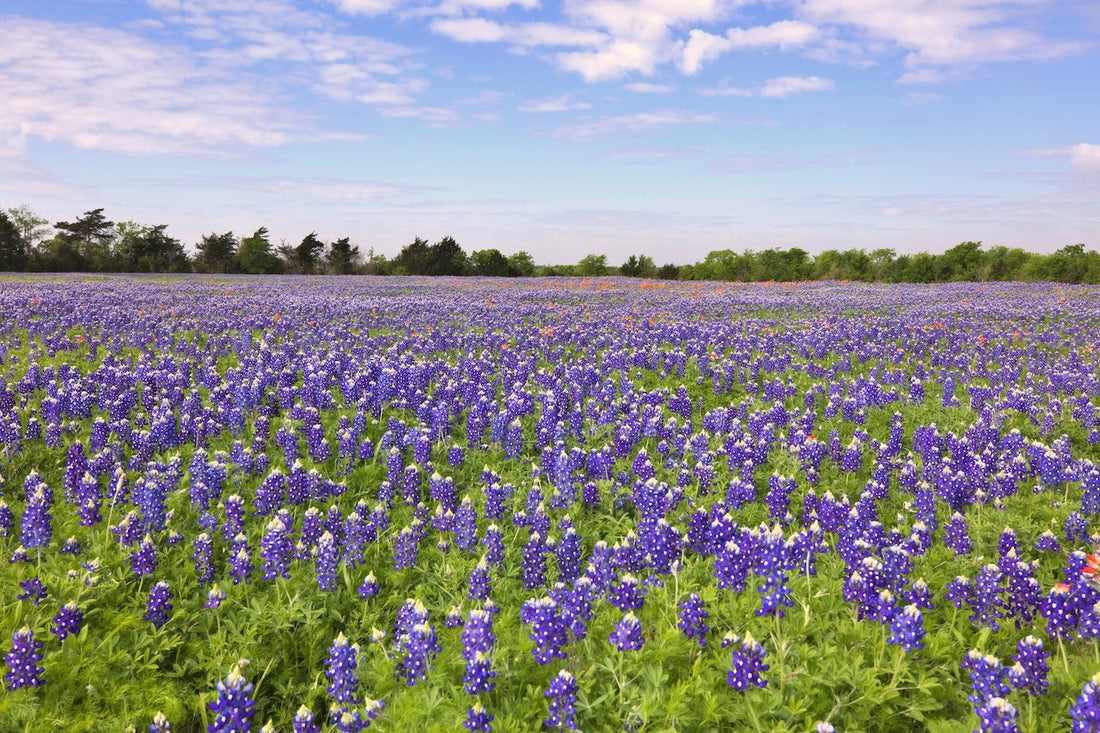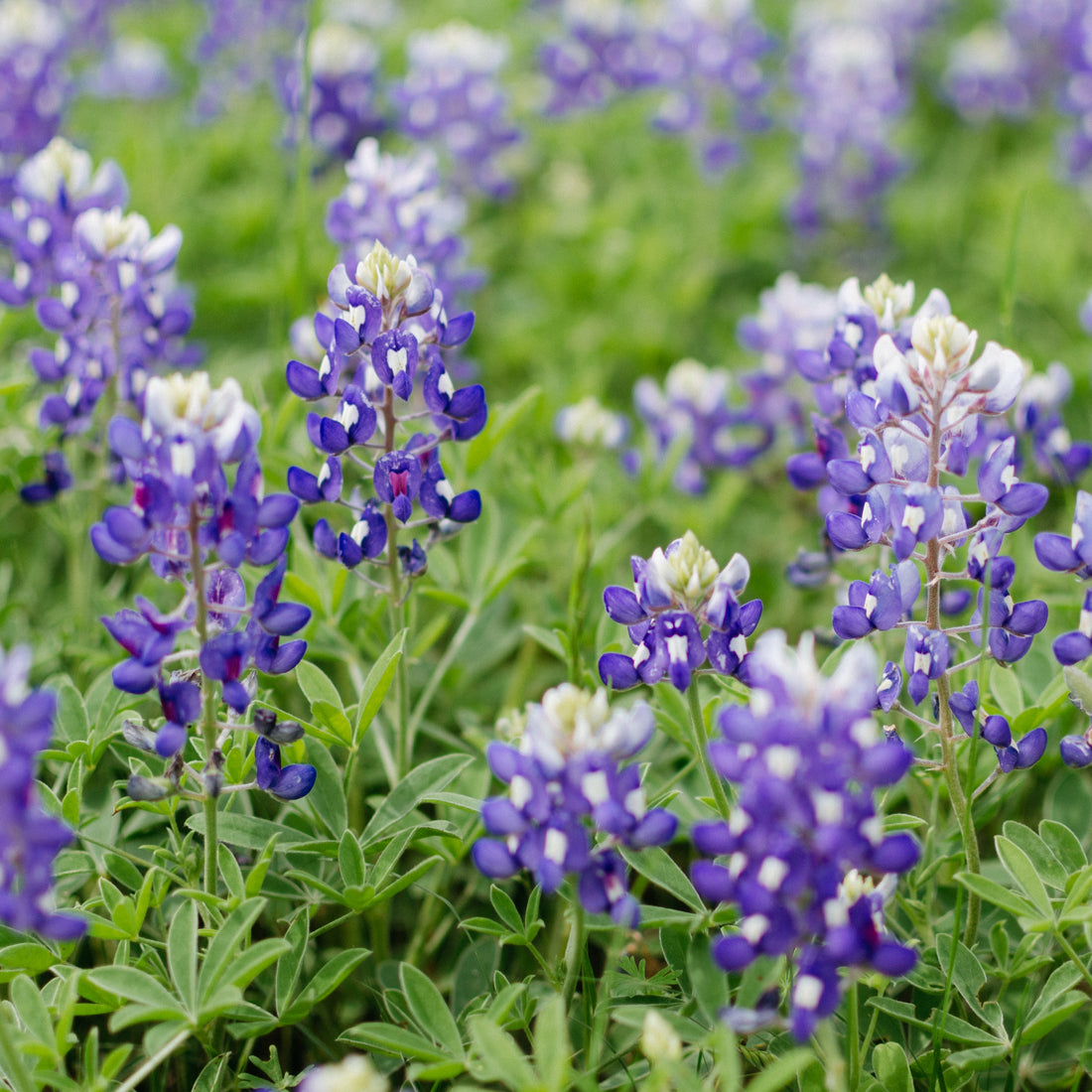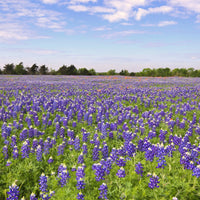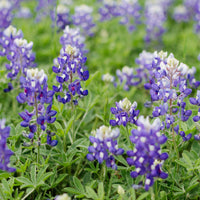
- When to plant:
- Fall
- Fertilizer:
- Varies
- Seeding rate:
- 40 lbs. per acre
- Overseeding rate:
- 20 lbs. per acre
- Seeding depth:
- 1/4 - 1/2 inch
- Ideal ph:
- 7.5
- Gmo:
- No
- Inoculant needed:
- No
- Coated or raw:
- Raw
- Lifecycle:
- Reseeding Annual
- Climate zones:
- Transition Zone, Warm Season
Texas Bluebonnets Wildflower Seed Mix – Nature's True Beauty Unleashed! Bring the breathtaking beauty of the Lone Star State into your own backyard with our Texas Bluebonnets Wildflower Seed. These iconic blooms, known as the state flower of Texas, are not just a sight to behold, but a symbol of the rugged and resolute spirit of the Texan landscape. Scientific Name: Lupinus texensis
Product Information
- Application or Use: Ornamental, Erosion Control, Forage, Cover Crop
- Germination Time: 21 - 28 days, under optimal conditions; seeds may lay dormant for years prior to germination
- Growing Locations: Warm Season, Transition Zone
- Height: 1 - 2 feet
- Sunlight Requirements: 8+ hours, full sun for best results, adaptable to both sun and partial shade.
- Advantages: Ornamental beauty, high protein source for wildlife, and tolerant of poor soils and thrives on neglect. Native, bee friendly, attracts butterflies, hummingbirds and birds, deer resistant, low maintenance, fragrant and mass plantings.
- When to Plant: See Instructions Tab.
Whether you're a Texan at heart or simply a lover of wildflowers, our Texas Bluebonnets Wildflower Seed will infuse your outdoor space with the vibrant, natural beauty that's synonymous with the Lone Star State. Experience the magic of Texas in your own backyard – order your seeds today and let the Bluebonnets bloom!
Wildflowers can provide an excellent alternative in large-scale, high-maintenance situations, as well as a satisfying change from traditional urban landscaping.
-
Authentic Texan Beauty: Our Texas Bluebonnets Wildflower Seed encapsulates the essence of the Texas countryside, adding a vibrant splash of color to your outdoor space. These lovely, deep-blue blooms with white-tipped petals are a source of pride for Texans and a treat for anyone who loves wildflowers.
-
Easy to Grow: Whether you're an experienced gardener or just starting out, our wildflower seeds are easy to sow and cultivate. With the right conditions, you'll soon have a sea of Bluebonnets in your garden.
-
Hardy and Resilient: These native Texas wildflowers are built to thrive in the region's sometimes harsh climate. Drought-tolerant and low-maintenance, they are perfect for busy gardeners and ideal for xeriscaping.
-
Attract Pollinators: Texas Bluebonnets are not just a delight for the eyes; they also attract essential pollinators like bees and butterflies, helping to support local ecosystems.
-
Versatile Landscaping: Plant them in your garden, alongside a walkway, or even in pots on your porch – Texas Bluebonnets will elevate any outdoor space with their natural charm.
-
Year-Round Beauty: These wildflowers provide a stunning show from late winter to early summer, ensuring that your garden is always adorned with their stunning blooms.
-
Great as Gifts: Share the beauty of Texas with friends and family by gifting them these wildflower seeds. They make a unique and thoughtful present for any occasion.
*Product packaging may appear different than what is pictured.
Wildflower Planting Time Based on Region:
Southeast
- Fall, Winter: Sowing wildflowers in Fall/Winter is the ideal time in the Southeast, with October 1 – December 31 being the best dates. The weather is ideal for starting seeds, and seedlings can grow and harden off before frost.
- Spring: A good time to plant wildflowers, especially annual species that flower quickly. Plant after the last frost date when soil temperatures have warmed to around 55°F, typically occurring within a month or so after the final frost of winter; this ensures the seeds can germinate properly without being affected by cold weather.
- Summer: You can plant wildflower seeds in the summer, but the hot sun can dry out the soil and stress your seedlings. Summer is a good time to plant quick-growing annual wildflowers.
Southwest
- Fall: A good time to plant spring wildflowers in the desert Southwest. Fall's cooler temperatures and seasonal rains help seeds germinate. In the mountains, you can plant after spring frosts.
- Winter: In areas that get snow, winter seeding can give seeds an advantage in the spring.
- Spring: A popular time to plant wildflowers in most states. You can plant after the last frost and when the soil temperature is at least 55°F. In warmer climates, you can plant at the end of the rainy season.
- Summer: You can plant wildflower seeds in the summer, but the hot sun can dry out the soil and stress your seedlings. Summer is a good time to plant quick-growing annual wildflowers.
Northeast
- Fall, Winter: The best time to plant wildflowers in the Northeast is in late fall, after the first frost but before heavy snow. This is known as dormant seeding and can take place from November to December. Cold temperatures and damp soil during the winter help wildflower seeds germinate.
- Spring: Plant in early spring, after the ground has thawed and soil temperatures reach around 55-65°F. This is a popular time to plant wildflowers because it's typically rainier, which helps water seedlings.
- Summer: You can plant wildflower seeds in the summer, but the hot sun can dry out the soil and stress your seedlings. Summer is a good time to plant quick-growing annual wildflowers.
Midwest
- Fall, Winter: Plant in late fall (November–December) after the first frost. The seeds will overwinter and germinate in the spring. Fall planting is a good option for cooler climates and can give the seeds an early start in the spring.
- Spring: Plant in early spring (April–May) after the last frost when the soil temperature is consistently above 55°F. Spring is a popular time to plant because the soil is usually moist from rain, and you can see the wildflowers grow right away.
- Summer: You can plant wildflower seeds in the summer, but the hot sun can dry out the soil and stress your seedlings. Summer is a good time to plant quick-growing annual wildflowers.
Western
- Fall, Winter: Plant in late fall (November–December) after the first frost. The seeds will overwinter and germinate in the spring. Fall planting is a good option for cooler climates and can give the seeds an early start in the spring.
- Spring: Plant in early spring (April–May) after the last frost when the soil temperature is consistently above 55°F. Spring is a popular time to plant because the soil is usually moist from rain, and you can see the wildflowers grow right away.
- Summer: You can plant wildflower seeds in the summer, but the hot sun can dry out the soil and stress your seedlings. Summer is a good time to plant quick-growing annual wildflowers.
Pacific Northwest
- Fall, Winter: Plant in late fall (November–December) after the first frost. The seeds will overwinter and germinate in the spring. Fall planting is a good option for cooler climates and can give the seeds an early start in the spring.
- Spring: Plant in early spring (April–May) after the last frost when the soil temperature is consistently above 55°F. Spring is a popular time to plant because the soil is usually moist from rain, and you can see the wildflowers grow right away.
- Summer: In cooler zones with higher elevation, you can plant wildflowers in late spring to early summer, after the risk of frost has passed. You can plant wildflower seeds in the summer, but the hot sun can dry out the soil and stress your seedlings. Summer is a good time to plant quick-growing annual wildflowers.
Planting Instructions:
-
Choose a sunny spot in your garden with well-drained soil.
-
Scatter the Texas Bluebonnets Wildflower Seed Mix evenly over the soil surface.
-
Gently press the seeds into the soil, but do not cover them with a thick layer of dirt.
-
Water the area thoroughly to help the seeds settle in and provide moisture for germination.
-
Watch with anticipation as the Bluebonnets spring to life!
When choosing to start a new lawn, remove old vegetation by using a de-thatcher, power rake or tiller to kill the existing vegetation. Rake or drag the area to remove debris and dead grass for a clean area. Ensure the soil is leveled and loosened to allow the seed to have good soil contact once spread on a clean seed bed.
If you have an area with heavy weed coverage, we recommend starting fresh by killing and removing the existing vegetation. If you choose to use chemicals, herbicides or fertilizers, you must check with the product's manufacturer prior to planting new seed to ensure the proper waiting period.
When overseeding an existing area, mow your lawn at the lowest setting and bag the clippingsx. Rake or drag any areas that have dead thatch or debris.

Seed Quality
Hancock Seed is dedicated to delivering the best seeds possible to our customers. Hancock Seed grows and harvests many of our products, and we acquire the majority of the rest from other family farmers.
All these seeds are processed, packaged and shipped from Hancock Farm. This helps us ensure that our high standards are met. Unlike much of the competition, we refuse to sell you a seed that was not gathered during the last harvest. You will always receive fresh product from Hancock.
Every seed we grow comes with 40 years of experience behind it...you can rest assured that all of our products are cultivated in a method that assures its potential for growth.

Your cart ( 0 )

Texas Bluebonnets Wildflower Seed Mix – Nature's True Beauty Unleashed! Bring the breathtaking beauty of the Lone Star State into your own backyard with our Texas Bluebonnets Wildflower Seed. These iconic blooms, known as the state flower of Texas, are not just a sight to behold, but a symbol of the rugged and resolute spirit of the Texan landscape. Scientific Name: Lupinus texensis
Product Information
- Application or Use: Ornamental, Erosion Control, Forage, Cover Crop
- Germination Time: 21 - 28 days, under optimal conditions; seeds may lay dormant for years prior to germination
- Growing Locations: Warm Season, Transition Zone
- Height: 1 - 2 feet
- Sunlight Requirements: 8+ hours, full sun for best results, adaptable to both sun and partial shade.
- Advantages: Ornamental beauty, high protein source for wildlife, and tolerant of poor soils and thrives on neglect. Native, bee friendly, attracts butterflies, hummingbirds and birds, deer resistant, low maintenance, fragrant and mass plantings.
- When to Plant: See Instructions Tab.
Whether you're a Texan at heart or simply a lover of wildflowers, our Texas Bluebonnets Wildflower Seed will infuse your outdoor space with the vibrant, natural beauty that's synonymous with the Lone Star State. Experience the magic of Texas in your own backyard – order your seeds today and let the Bluebonnets bloom!
Wildflowers can provide an excellent alternative in large-scale, high-maintenance situations, as well as a satisfying change from traditional urban landscaping.
-
Authentic Texan Beauty: Our Texas Bluebonnets Wildflower Seed encapsulates the essence of the Texas countryside, adding a vibrant splash of color to your outdoor space. These lovely, deep-blue blooms with white-tipped petals are a source of pride for Texans and a treat for anyone who loves wildflowers.
-
Easy to Grow: Whether you're an experienced gardener or just starting out, our wildflower seeds are easy to sow and cultivate. With the right conditions, you'll soon have a sea of Bluebonnets in your garden.
-
Hardy and Resilient: These native Texas wildflowers are built to thrive in the region's sometimes harsh climate. Drought-tolerant and low-maintenance, they are perfect for busy gardeners and ideal for xeriscaping.
-
Attract Pollinators: Texas Bluebonnets are not just a delight for the eyes; they also attract essential pollinators like bees and butterflies, helping to support local ecosystems.
-
Versatile Landscaping: Plant them in your garden, alongside a walkway, or even in pots on your porch – Texas Bluebonnets will elevate any outdoor space with their natural charm.
-
Year-Round Beauty: These wildflowers provide a stunning show from late winter to early summer, ensuring that your garden is always adorned with their stunning blooms.
-
Great as Gifts: Share the beauty of Texas with friends and family by gifting them these wildflower seeds. They make a unique and thoughtful present for any occasion.
*Product packaging may appear different than what is pictured.
Wildflower Planting Time Based on Region:
Southeast
- Fall, Winter: Sowing wildflowers in Fall/Winter is the ideal time in the Southeast, with October 1 – December 31 being the best dates. The weather is ideal for starting seeds, and seedlings can grow and harden off before frost.
- Spring: A good time to plant wildflowers, especially annual species that flower quickly. Plant after the last frost date when soil temperatures have warmed to around 55°F, typically occurring within a month or so after the final frost of winter; this ensures the seeds can germinate properly without being affected by cold weather.
- Summer: You can plant wildflower seeds in the summer, but the hot sun can dry out the soil and stress your seedlings. Summer is a good time to plant quick-growing annual wildflowers.
Southwest
- Fall: A good time to plant spring wildflowers in the desert Southwest. Fall's cooler temperatures and seasonal rains help seeds germinate. In the mountains, you can plant after spring frosts.
- Winter: In areas that get snow, winter seeding can give seeds an advantage in the spring.
- Spring: A popular time to plant wildflowers in most states. You can plant after the last frost and when the soil temperature is at least 55°F. In warmer climates, you can plant at the end of the rainy season.
- Summer: You can plant wildflower seeds in the summer, but the hot sun can dry out the soil and stress your seedlings. Summer is a good time to plant quick-growing annual wildflowers.
Northeast
- Fall, Winter: The best time to plant wildflowers in the Northeast is in late fall, after the first frost but before heavy snow. This is known as dormant seeding and can take place from November to December. Cold temperatures and damp soil during the winter help wildflower seeds germinate.
- Spring: Plant in early spring, after the ground has thawed and soil temperatures reach around 55-65°F. This is a popular time to plant wildflowers because it's typically rainier, which helps water seedlings.
- Summer: You can plant wildflower seeds in the summer, but the hot sun can dry out the soil and stress your seedlings. Summer is a good time to plant quick-growing annual wildflowers.
Midwest
- Fall, Winter: Plant in late fall (November–December) after the first frost. The seeds will overwinter and germinate in the spring. Fall planting is a good option for cooler climates and can give the seeds an early start in the spring.
- Spring: Plant in early spring (April–May) after the last frost when the soil temperature is consistently above 55°F. Spring is a popular time to plant because the soil is usually moist from rain, and you can see the wildflowers grow right away.
- Summer: You can plant wildflower seeds in the summer, but the hot sun can dry out the soil and stress your seedlings. Summer is a good time to plant quick-growing annual wildflowers.
Western
- Fall, Winter: Plant in late fall (November–December) after the first frost. The seeds will overwinter and germinate in the spring. Fall planting is a good option for cooler climates and can give the seeds an early start in the spring.
- Spring: Plant in early spring (April–May) after the last frost when the soil temperature is consistently above 55°F. Spring is a popular time to plant because the soil is usually moist from rain, and you can see the wildflowers grow right away.
- Summer: You can plant wildflower seeds in the summer, but the hot sun can dry out the soil and stress your seedlings. Summer is a good time to plant quick-growing annual wildflowers.
Pacific Northwest
- Fall, Winter: Plant in late fall (November–December) after the first frost. The seeds will overwinter and germinate in the spring. Fall planting is a good option for cooler climates and can give the seeds an early start in the spring.
- Spring: Plant in early spring (April–May) after the last frost when the soil temperature is consistently above 55°F. Spring is a popular time to plant because the soil is usually moist from rain, and you can see the wildflowers grow right away.
- Summer: In cooler zones with higher elevation, you can plant wildflowers in late spring to early summer, after the risk of frost has passed. You can plant wildflower seeds in the summer, but the hot sun can dry out the soil and stress your seedlings. Summer is a good time to plant quick-growing annual wildflowers.
Planting Instructions:
-
Choose a sunny spot in your garden with well-drained soil.
-
Scatter the Texas Bluebonnets Wildflower Seed Mix evenly over the soil surface.
-
Gently press the seeds into the soil, but do not cover them with a thick layer of dirt.
-
Water the area thoroughly to help the seeds settle in and provide moisture for germination.
-
Watch with anticipation as the Bluebonnets spring to life!
Instructions
When choosing to start a new lawn, remove old vegetation by using a de-thatcher, power rake or tiller to kill the existing vegetation. Rake or drag the area to remove debris and dead grass for a clean area. Ensure the soil is leveled and loosened to allow the seed to have good soil contact once spread on a clean seed bed.
If you have an area with heavy weed coverage, we recommend starting fresh by killing and removing the existing vegetation. If you choose to use chemicals, herbicides or fertilizers, you must check with the product's manufacturer prior to planting new seed to ensure the proper waiting period.
When overseeding an existing area, mow your lawn at the lowest setting and bag the clippingsx. Rake or drag any areas that have dead thatch or debris.


















